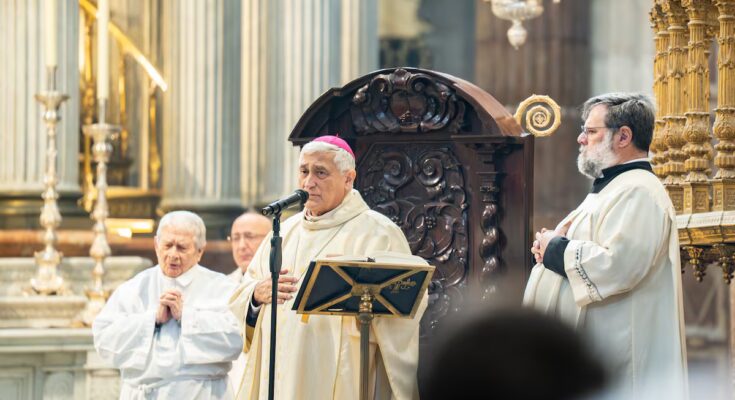EL PAÍS launched an investigation into pedophilia in the Spanish Church in 2018 and did a database updated with all known cases. If you know of any cases that have not seen the light of day, you can write to us at: Abusos@elpais.es. If it is Latin America, the address is: abusesamerica@elpais.es.
───────────
The case of abuse for which the Vatican ordered the opening of a canonical investigation against the bishop of Cadiz and Ceuta, Rafael Zornoza, has once again placed the pedophilia scandal in the Spanish Church at the center of the media agenda. The news is relevant because it is the first time that a Spanish prelate has been accused of sexual violence against minors. Furthermore, it once again highlights how the Spanish episcopate manages these cases: only 2% of the victims it recognizes (there are fewer than fifty) have been compensated, it refuses to collaborate with the government to create a fund to pay compensation, it does not respect many Vatican guidelines and it has not yet addressed the cover-up of dozens of cases. And questions arise to understand what happened. How did the case against Zornoza come about? How will the investigations against him be carried out? Will he leave office? What role will Pope Leo XIV have in this process? These are the five keys to the Zornoza case:
A complaint to the Vatican
The victim accusing Zornoza sent her complaint in a letter directly to the Vatican this summer. The letter was sent to the Dicastery for the Doctrine of the Faith, a body of the Holy See responsible, among other things, for monitoring all cases of pedophilia in all the dioceses of the world. The complainant describes in that letter that the abuse – touching, caressing the private parts and kissing on the mouth – began in 1994, when he was 14 years old, and continued until he was 21 years old. The current bishop of Cadiz was then directing the seminary of Getafe, in Madrid. The sexual violence described by the victim occurred at night: “He came into the room and suffered the abuse. He entered my bed, caressed me and kissed me.”
The abuse continued even after he reached adulthood and entered the major seminary. During this period, the letter states, Zornoza went to bed “almost every night and every morning” to kiss him and touch his private parts. “On several occasions I complained to Rafa that what we were doing wasn’t right. He always told me that it was an intimate friendship,” the victim writes. This story was deemed credible by the Dicastery for the Doctrine of the Faith and ordered the opening of a canonical investigation in July, since the crime was time-barred.
The case reaches the Court of Rota
Ecclesiastical legislation provides that canonical investigations into pedophilia affecting a bishop are the responsibility of the metropolitan see on which the diocese of the accused depends. Therefore, the Dicastery for the Doctrine of the Faith sent Zornoza’s case to the archbishopric of Seville, of which the bishopric of Cadiz and Ceuta is a suffragan. But the Sevillian archbishop, José Ángel Meneses, distanced himself from the issue and referred the canonical procedure to the Tribunal of the Rota of the Nunciature in Spain, based in Madrid. Finally, this instance opened a preliminary investigation last week, which is still open and in which statements from the victim, the accused and some witnesses are awaited. Sending a dossier to this body, which depends on the Nunciature – the Embassy of the Holy See in Spain – is an option that dioceses have if they prefer not to deal with a complex complaint.
Once this preliminary investigation is completed, it is sent to the Vatican. Subsequently, the Holy See will decide whether or not to open proceedings which will end with a canonical trial and a sentence. The resolution is also sent to the Doctrine of Faith for ratification.
Zornoza’s dismissal
Another important issue in the case is that neither the Vatican nor the Spanish Church took precautionary measures against Zornoza. The procedure began four months ago and throughout this time the prelate continued to maintain contact with the minors and carry out his public agenda normally. From the moment the investigation was opened, according to canon law specialists, the Dicastery for the Doctrine of the Faith could have already taken precautionary measures, such as removal from office. Especially if you take into account the seriousness of the case when dealing with a bishop. Likewise, both the Archbishopric of Seville and the Tribunal de la Rota could have intervened when they received the ordinance.
In fact, the Pontifical Commission for Minors of the Holy See recommends it in its latest report accelerate the dismissal of priests implicated in cases of abuse. The commission highlighted “the importance of a simplified protocol for the resignation or removal of Church leaders or staff in cases of abuse or neglect.” But none of this was done and only after EL PAÍS made the news of the investigation public did the Spanish Church and the Vatican prepare for an imminent replacement of the bishop of Cadiz, as ecclesiastical sources close to the process describe to this newspaper. The same sources say that Zornoza’s departure is imminent.
The accused prelate, however, announced this Monday, after the investigation was made public, that he will suspend his agenda “to clarify the facts” and denies having abused minors in Getafe.
The Spanish Church and the cover-up
The cover-up is one of the key points in understanding the child sexual abuse scandal within the Catholic Church. This explains that, beyond the hundreds of cases and thousands of victims, there was a method of action by the ecclesial hierarchies to cover up the issue, sometimes by the Vatican itself. Pope Francis reformed canonical norms in 2019 to toughen penalties for the protection of pedophiles and the silencing of victims. But the Spanish Church looks the other way. When questioned on numerous occasions on this issue, the EEC leaders always state that there is no open investigation and refuse to answer why it is not being investigated. to the dozen bishops and cardinals still alive suspected of covering up sexual abuse.
Some of these prelates continue to participate in votes in which the EEC makes decisions, among other issues, on the management of pedophilia within it. In the plenary sessions of recent years, for example, the bishops have attacked everyone. Against journalistic investigations, such as that of EL PAÍS; against the report of the Civic Guarantor, which in 2023 estimates the victims of the last decades at 440 thousand; against the same audit commissioned by the Cremades & Calvo-Sotelo company; and also against the Government, which last year approved a plan to compensate those affected with a fund in which the Church also collaborated. Not only that, the Executive’s plan also called for an independent body to investigate every case, whether of abuse or cover-up, which would allow the names of the accused, dates and locations to be officially recorded.
Trial by fire for Leo XIV
The Zornoza case also reaches the gates of the Vatican and represents a first litmus test for Leo XIV in the face of the pedophilia scandal in the Spanish Church. His predecessor, Francisco, never wanted to rebuke the Spanish ecclesiastical hierarchy, despite the hundreds of cases discovered by EL PAÍS or the conclusions of official reports such as that of the Ombudsman which showed the lack of collaboration of “some bishops” to clarify the issue and compensate the victims.
Now Zornoza’s dismissal depends on the Vatican. Spanish ecclesiastical sources indicate that the Dicastery of Bishops will sign the document. The Pope faces what could be the first serious case of pedophilia that comes to his table in order to intercede and lead him to take a new position towards the Spanish episcopate and its deficient and opaque way of managing the issue of pedophilia.



